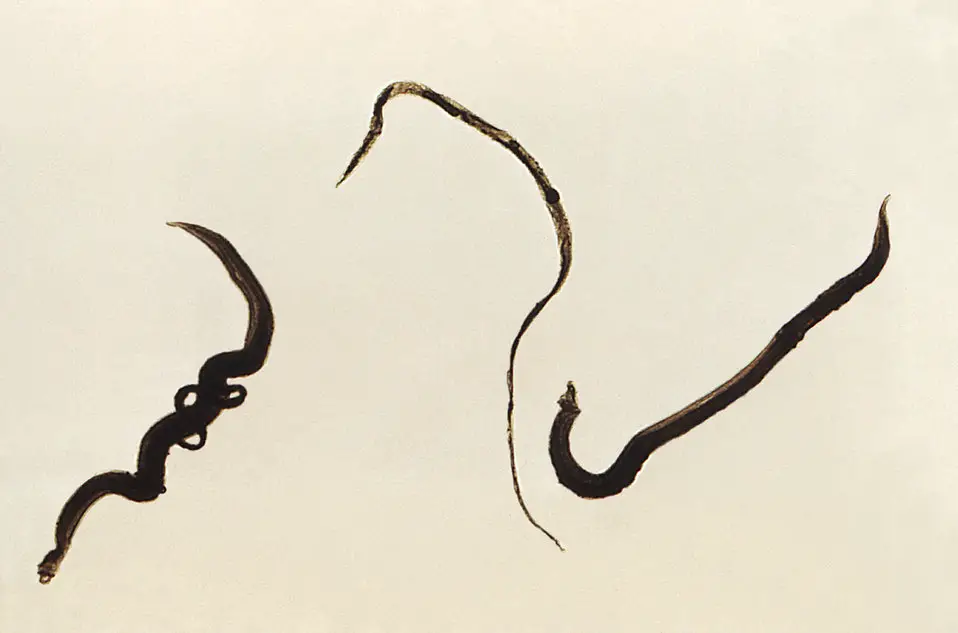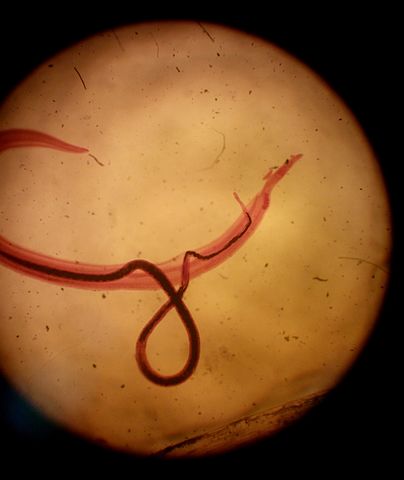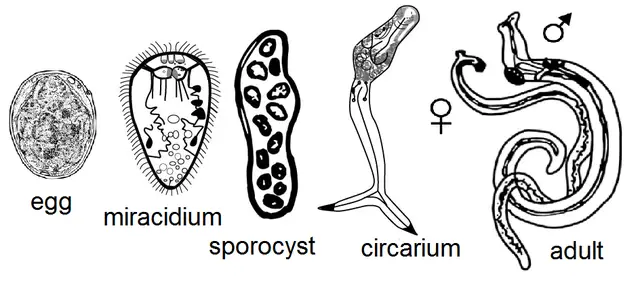Trematodes
** What are they?, Classification, Morphology and Life Cycle
Definition: What are Trematodes?
Also known as flukes, trematodes are a group of parasitic flatworms (leaf-shaped). Although they are mostly associated with such aquatic fauna as fish and mollusks, they also affect various vertebrates as part of their indirect life cycle.
They are organisms of veterinary and medical importance (given that they infect and affect both human beings and animals). With over 20,000 species in the class Trematoda, trematodes can be found in various habitats across the globe.
Depending on the species, trematodes may depend on one or several hosts to complete their life cycle.
Some examples of trematodes include:
- S. japonicum
- S. haematobium
- P. heterotremus
- F. hepatica
- C. sinensis
- P. westermani
- S. hematobium
Classification
· Kingdom: Animalia - As part of this kingdom, trematodes consume organic material, use oxygen (when it is available), are capable of movement and can reproduce and grow.
· Phylum: Platyhelminthes - Trematodes belong to the phylum Platyhelminthes (flatworms) and thus characterized by bilateral symmetry.
· Orders: Monogenea and Digenea - Obligate parasites
* There are over 20,000 species of Trematoda that can be divided into approximately 2,200 general and about 256 families.
Morphology
While different trematode species may possess features that are absent in others, they share a number of morphological features. For instance, like most platyhelminths, trematodes are defined by dorsoventrally flattened (unsegmented) bodies that are bilaterally symmetrical. They have a leaf-shaped body.
These are characteristics particularly used to describe various trematode species. While a majority of species are small, only measuring a few millimeters in length, some species can grow to up to 10 centimeters long.
While they have a morphologically and physiologically complex tegument (body covering), trematodes do not have a body cavity. As a result, their organs are bound in parenchyma while the somatic muscle layers in the parenchyma attach to the tegument.
However, they have a well-developed (and branched) alimentary canal that consists of an esophagus and muscular pharynx. Despite being well developed, the intestine does not open out through an anus. Rather, the two branches run into a common pore (excretory vesicle) located at the posterior end of the organism.
* The alimentary canal of trematodes is covered by a single layer of epithelial cells.
* Depending on the species, trematodes may have secondary or tertiary branches of the intestine.
* Apart from lacking a body cavity, trematodes also lack a respiratory system.
For attachment purposes, adult trematodes possess two specialized suckers. One of these suckers is located around the mouth area/opening while the other is located in the middle part of the body. These allow trematodes to remain attached to their host.
Using the powerful muscular pharynx that makes up the mouth part, trematodes (both the larvae and adult stages) are able to suck food from the host as they remain attached using both the posterior and ventral suckers. Here, the muscular structures function as powerful pumps that suck blood from the host as a source of nutrition (which causes harm to the host).
* Whereas the oral sucker of trematodes contributes to the feeding process, the ventral sucker is only for attachment purposes.
As mentioned, the branched alimentary canal of trematodes does not open up in an anal opening, for this reason, waste products are excreted through the mouth opening from the excretory vesicle.
With regards to reproduction, a majority of trematodes have been shown to be hermaphroditic. As such, an individual has both the male and female reproductive organs.
Here, the male reproductive system consists of:
- Two testes
- Accessory glands
- A cirrus (acts as the penile part)
The female reproductive system consists of:
- An ovary
- Seminal receptacle
- Yolk glands
- Ootype
- Oviduct
While the majority of trematodes are hermaphroditic and use self-fertilization to reproduce, they have also been shown to reproduce through cross-fertilization. Here, one individual is capable of fertilizing another.
Depending on the species, the larval stage goes through several stages of development before reaching maturity. This may occur in different hosts from aquatic organisms to vertebrates.
* Blood flukes are not hermaphroditic and thus do not possess both the male and female reproductive organs.
* The eggs of trematodes are characterized by a hard and smooth shell that is yellow-brown in color. The eggs may also have spines and vary from 30 to 175 microns depending on the species.
Aspidogastrea and Digenean Trematodes
Aspidogastrea and digenean trematodes make up the two major groups of Trematoda. The two groups are distinguished based on their structures and development process.
Monogenea
Although they are still described as monogenean trematodes in some books today, studies have shown that monogenea are not really trematodes. Rather, they are a phylogenetically distinct group of platyhelminths that are characterized by a posterior holdfast organ known as the opisthaptor they use for anchorage.
Most of the species in this group are fish parasites but some species have been found to infect turtles.
Digenean Trematodes
The sub-class Digenea is the largest group of parasitic Platyhelminthes. Like many of the other platyhelminths, digeneans are endoparasites and thus found inside the body of the host.
Their complex life cycle is dependent on different species of animals including all vertebrates and most of the invertebrates found on land, freshwater as well as marine environments. While Digenean trematodes are parasitic in nature, studies have them to be free-living in two stages of their life cycle. These include the miracidium and cercaria larval stages.
Morphologically, Digenea is characterized by an oval, dorso-ventrally flattened body. They also have a smooth surface with spines as well as anterior and ventral suckers. For Digenea, both suckers are used for attachment and locomotion purposes.
Like the other trematodes, Digenea also have a mouth opening as well as a branched intestine. For the most part, Digenea are hermaphrodites with some species having a copulatory organ.
* Digenea consists of over 18,000 nominal species divided into 150 families.
* Life cycle starts in aquatic environments, proceeds in semi-aquatic environments and ends in terrestrial environments.
* In human beings, they cause such diseases as schistosomiasis.
Aspidogastrea
As compared to Digenea, Aspidogastrea is a smaller group composed of about 80 species of trematodes. Although they are parasites of various aquatic organisms including mollusks and vertebrates, Aspidogastrea have a simpler life-cycle limited to mollusk and a vertebrate host (facultative or compulsory).
Like Digenea, Aspidogastrea are also endoparasites. They are characterized by a holdfast organ that lacks a hook covering the ventral side, a row of suckers as well as tegument consisting of microtubercles. The adhesive disc is composed of between 3 and 4 rows of alveoli.
Some of the other aspects that characterize Aspidogastrea include:
· Larvae possess posterior suckers. They may also have a false, anterior sucker.
· In adults, posterior and ventral suckers are replaced by the adhesive disk that is marked by transverse grooves.
· They vary in length from a few millimeters to several centimeters.
Nervous System
Trematodes have a primitive nervous system that consists of two ganglia on either side of the esophagus. The pair is connected to each other through a nerve ring that goes around the esophagus. Apart from this simple system trematodes do not have any additional sensory organs as is the case with flatworms.
Reproduction and Life Cycle
As mentioned, a majority of trematodes are hermaphrodites which means that individuals possess both male and female reproductive organs. This makes self and cross-fertilization possible and so can fertilize themselves and each other.
Apart from sexual reproduction, trematodes are also capable of asexual reproduction at given stages in their life cycle. This section will focus on the life cycle of Liver flukes (to represent trematodes) given that they can reproduce sexually and asexually and depend on several hosts to complete their life cycle.
* As the name suggests. liver fluke parasitizes the liver of various mammals. However, they can also be found in the gallbladder and bile ducts of these animals.
The life cycle of liver flukes like Fasciola hepatica starts when eggs laid in the bile ducts of a mammal (man, pigs, cows, etc) are released into the environment with the feces. In aquatic or very damp environments, the eggs develop to embryos within a period of three weeks.
The eggs hatch in favorable conditions of between 10°C and 15°C. The embryo (also known as miracidium) possess cilia so are capable of swimming. This allows them to swim in their environment in search of a favorable host.
For Fasciola hepatica, mollusks in aquatic environments are suitable hosts. They act as intermediate hosts for the larval stages of the liver fluke.
* An intermediate host refers to a host that supports the development of the immature parasites (larvae etc). Some of the parasites in this state are also incapable of reproduction.
* The ciliated embryo may swim for several hours in search of an intermediate host.
In the intermediate host (the snail) the larvae go through several stages of proliferation (asexually) and develop into cercariae. Typically, in the asexual phase, the larval will lose their hair-like fibers and develop into a new larval form. The new larvae also goes through further asexual proliferation/development within the intermediate host where they develop into cercariae.
* Miracidia that enter the snail undergoes asexual proliferation to produce cercariae.
The new larvae (cercariae) leaves the intermediate host through its pulmonary cavity and migrate to wet herbaceous vegetation (e.g. grass) where they encyst to form metacercariae. In this state, the metacercariae can survive various harsh environmental conditions for several months because the tough outer covering protects the organism.
* Metacercariae which is a cyst form is an infective stage to mammals.
Mammals, which are the definitive host of the parasite are infected once they ingest the metacercariae. This particularly affects such animals as cows and sheep that tend to feed on vegetation.
Although human beings have been shown to be reservoir of the parasite, studies have concluded that for Fasciola hepatica, human beings are not the ideal definitive host.
Following ingestion, the metacercariae excyst in the intestine (duodenum) from where they migrate to the peritoneal cavity through the intestinal wall. At this stage, the parasite is still immature. It's only when they reach the biliary ducts that they mature and develop to become adults.
* Human beings are likely to be infected (Human fascioliasis) by ingesting contaminated plants in damp conditions or raw fresh carrying the infective stage of the parasite.
Like a majority of the other trematodes, liver flukes (Fasciola Hepatica in this case) are hermaphrodites. As such, they have both male and female reproductive systems. Within the biliary ducts, this allows them to self-fertilize (as well as cross-fertilization) in order to produce fertilized eggs.
In the case of cross-fertilization, copulation is followed by the insertion of the cirrus of one trematode into the Laurer's canal of another. This allows for sperm cells to be deposited into the oviduct of one parasite for fertilization to occur.
This is different from self-fertilization where sperm cells from the same individual are released into the female reproductive system to fertilize the eggs within the oviduct.
Fertilized eggs, which are oval and brown in color, are then excreted with the feces and the cycle continues.
Some of the most common infections caused by trematodes include:
- Clonorchiasis
- Fascioliasis
- Opisthorchiasis
- Paragonimiasis
Cestodes Vs. Trematodes
Like trematodes, cestodes (tapeworms) belong to the phylum Platyhelminthes.
They share a number of similarities including being multicellular, bilateral symmetry, being endoparasites, as well as lacking a body cavity. While they have a number of similarities, the two also have various differences. These are evident in their mode of reproduction, life cycle, and morphology among others.
Unlike trematodes that can be found in mollusks in their larval stages, tapeworms/cestodes can be found in vertebrates. In the host, cestodes like tapeworms obtain nutrients through absorption given that they do not have a digestive tract and so nutrients are absorbed through the surface of their body. This is different from trematodes that use their muscular mouth opening to suck blood from the host.
Whereas cestodes possess hooks through which they attach onto the walls of the host (in the intestine) trematodes use suckers that may be anterially or ventrally positioned.
In trematodes, however, these may also be used for movement. Unlike trematodes, the bodies of cestodes are segmented into sections known as proglottids. These segments grow from the scolex (head region of cestodes) and may break off.
Each of these segments contains both male and female reproductive organs that allow them to self-fertilize. While cestodes are capable of self-fertilization, like trematodes, trematodes do not have segmented bodies attached to a scolex.
When the eggs are released from the hind segments, they are excreted to the aquatic environment from where they may be consumed by other mammals or fish in which allows their life cycle to continue when they are consumed by man.
This is different from the life cycle of various trematodes that strictly requires aquatic intermediate hosts such as mollusks for the larval stages to develop.
In mammal hosts, tapeworms are confined to the intestine where they obtain nourishment and produce eggs. This is not the case with trematodes that can be found in other body organs including the lungs, blood and bile ducts (these being in addition to the intestine).
Some of the other differences between the two include:
· Trematodes have a more complex life cycle.
· The eggs of trematodes are ciliated which allows for movement in aquatic environments (to reach the intermediate host).
· Cestodes have a tubular morphology and are longer in length while trematodes are smaller with a leaf-like morphology.
Return to Multicellular Organisms main page
Return to phylum Platyhelminthes
Return to learning about Helminths
Return to Parasites under the Microscope
Return from Trematodes to MicroscopeMaster home
References
Barbara L. Doughty. (1996). Chapter 88Schistosomes and Other Trematodes. Medical Microbiology. 4th edition.
Katarzyna Niewiadomska, Teresa Pojmańska. (2011). Multiple strategies of digenean trematodes to complete their life cycles
Klaus Rohde. (2011). The Aspidogastrea: A Parasitological Model I..
Mailles A., Capek I., Ajana F., Schepens C., Ilef D., Vaillant V., (2006). Commercial watercress as an emerging source of fascioliasis in Northern France in 2002: results of an outbreak investigation. Epidemiol Infect 2006;1-4.
Seaton D.R. (1979) Cestodes and Trematodes. In: Donaldson R.J. (eds) Parasites and Western Man. Springer, Dordrecht.
Links
https://www.ncbi.nlm.nih.gov/books/NBK8282/
https://www.newworldencyclopedia.org/entry/Fluke
Find out how to advertise on MicroscopeMaster!







